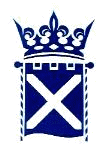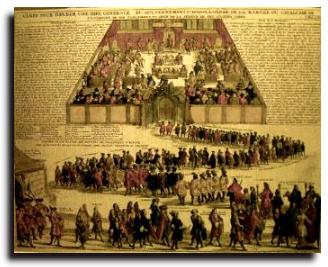Part 1: The Early Years

Scottish Parliament - Yesterday and Today
Part 1: The Early Years

The Earliest Times
In medieval times, the concept of a "parliament" would have been unheard of at a time when clan chiefs or minor kings ruled without question. There may have been groups of elders who gave "advice" but the leader of the society was often there by force of arms. After the Norman Conquest in England in 1066, the principle of king and vassals was reinforced. But the Normans did have a concept of a gathering of the most important nobles - though a strong king did not need to listen to them. In Scotland, the first Royal Council was convened by King David I in the first half of the 12th century and his grandson, King William the Lion, convened the "Curia Regis" - an early form of parliament, though there was no question of the participants being elected.The Three Estates
The idea of the king being required to consult about the passing of laws came to the fore in England in the 13th century with the signing of the Magna Carta by King John. Of course, this was more about confirming the power of the nobles - commoners were still vassals of their lords. In Scotland, the first reference to the King's High Court of Parliament does not occur until 1293 although the term "parliament" was first recorded in 1235.Robert the Bruce continued the concept of convening a parliament of nobles and clergy in various locations around Scotland but it is the assembly of Scottish nobles and clergymen in Arbroath on April 6, 1320, which is remembered most vividly. Not just for "as long as but a hundred of us remain alive, never will we on any conditions be brought under English rule" but also for stating that the king would be driven out if he subjected the kingdom to the English. Not quite democracy, but a step towards establishing that the king was not in sole charge. Later in his reign, Robert the Bruce convened a parliament in 1326 which included representatives from the burghs (important towns given rights by the king). This established what became known as the "Three Estates" - nobles, senior clergy and burgh commissioners. For some time, these were the sole members of the Parliament. As a consequence, much of the Highlands and Islands, with few recognised nobles and even fewer burghs, were badly under-represented.
Even if those actually entitled to vote were small in number, there was nevertheless a general belief in Scotland in the rights to freedom and all men being equal.
Meetings of Parliament were not held on a regular basis - the king would convene a meeting by summoning the participants. Between meetings, the "Lords of the Articles" carried on the work of a parliament; since appointment to this group was at the discretion of the monarch, he had a considerable influence over its decisions.
Reformation and Civil War
Although the Reformation of the church in the 16th century was primarily about religious issues, it was also about challenging the authority of the church in Rome - and also the absolute power of the monarch. Until this time, all legislation had to be given the Royal Assent and the king was always present at the meetings of Parliament. While Mary Queen of Scots was in France (she had married the heir to the French throne) the Scottish Parliament was allowed to meet without her. The "Reformation Parliament" was an important step forward which was continued when the infant King James VI ascended the throne. A series of Regents tried to rule in his name - and were frequently assassinated as a result. Meetings of Parliament frequently had to be held behind locked doors to avoid the intrusions of rival factions.
When King James VI (pictured here) eventually took over, he refused to convene a full Parliament but ruled instead via a "Convention of the Noble Estate" which consisted of his appointees. His son, King Charles I, who believed in the "Divine Right of Kings" which meant that he considered he was above Parliament, was to carry the conflict further. But first, he decreed that the Scottish Parliament should have a "fixed abode" and Parliament House in the centre of Edinburgh was built as the a permanent structure to house the institution. The illustration below shows a drawing of the Members of the Scottish Parliament in a procession from the Palace of Holyroodhouse to Parliament House for the annual opening, a ceremony known as the "Riding of Parliament".

When Charles I visited Scotland in 1633 (for the one and only time) he attended Parliament, sitting on a raised dais and overseeing the proceedings. He had already dissolved the Westminster Parliament in 1629 and that body did not meet, at least officially, for eleven years after that. Eventually the conflict between monarch and the English parliament reached breaking point and Civil War broke out. The Scots Parliament was persuaded to join in. But later, after the execution of King Charles I and the declaration of a republic in England, the Scots Parliament went its own way and resolved to invite his son, Charles II to be King of Scotland. He was duly crowned at Scone in 1651. Oliver Cromwell, the Puritan leader, brought the English army north and after luring the Scots army into England, crushed them at the Battle of Worcester. King Charles II fled and the "Commonwealth" was formed and, for a spell, the Scottish Parliament was dissolved. The Parliament in London had representatives from England, Wales, Scotland and Ireland. However, after the Restoration of King Charles II in 1660, the Scottish Parliament was revived.
Next page > Union of the Parliaments > Page 1, 2, 3, 4, 5.
Where else would you like to go in Scotland?

